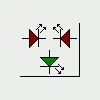-
Posts
45 -
Joined
-
Last visited
Never
About nickagian
- Birthday 01/25/1985
Recent Profile Visitors
The recent visitors block is disabled and is not being shown to other users.
nickagian's Achievements
Newbie (1/14)
0
Reputation
-
Great! Then I think the .pdf is perfect for your switch! As I also said, you can use a MOSFET instead of the BJT in case you need more current (moreover with MOSFET I think you don`t have to use any resistor)
-
Hi jarmund! I`m afraid that I can`t help you with the first point. However concerning the second one you can have a look at this topic : http://www.electronics-lab.com/forum/index.php?topic=171.0, you may find it useful. I haven`t yet, but I think it worths a try. I`m interested in a guide about PCB too!
-
Hi haji_timur! What do you need the switch for? Is it a digital +5V/0V switch probably? Can you give us some more information about it? However have in mind that probably you have to use a BJT or MOSFET. Have a look at the .pdf below. Transistor.pdf
-
I guess you are right... I have a problem with one circuit containing the `07 and thought it was burned...so I checked it seperately and found this behaviour strange. But you are right with that open collector. Thank you!
-
Hi all! I am confused a little bit with something related with the IC 74LS07. This IC has buffers, isn`t that correct? So let`s choose the first gate and apply +5V at the input (1A). I expect to get +5V at the output of the gate (1Y), right? So why is that not working with my chips? ??? (I have already checked two of them). I cannot understand what is my mistake... :(
-
Hi defaced! Well this is what I have learned in my university: 1)At a half-rectifier circuit (look at the first two circuits at the picture posted by Ante) the output voltage amplitude is given by the formula Vout(amp)=E(rms)xsqrt(2)-VD0 [sqrt->square root, E the voltage at the secondary of the transformer and VD0-> the forward voltage of the diode, about 0.7~0.8V] Since sqrt(2) is approximately 1.4 you can say that Vout(amp)=1.4E(rms)-VD0 so roughly Vout(amp)=1.4E(rms). This is one of the formulas that you can see in the picture. Moreover the DC output voltage (practically the average voltage) can be calculated by the formula VDC=1.4E(rms)/pi - VD0/2 and since 1.4/pi is approximately 0.45, you can say that VDC=0.45E(rms) (That means probably the second formula at the picture) However if you use a simple capacitor for filtering, the output voltage roughly equals the output voltage amplitude, thus 1.4E(rms). 2)For the full-rectifier circuit (both with the two diodes and the bridge-rectifier) the output voltage amplitude equals Vout(amp)=2*1.4E(rms)-VD0 thus approximately 2.8E(rms) and the DC level VDC=2*1.4E(rms)/pi - VD0 so approximately 0.9E(rms) That`s all! 8) ;)
-
I mean an IR emmiter and an IR receiver, I have called this a 'couple' because they cooperate with each other. In fact they are two seperate devices!
-
Moreover I want to add that my idea is to use two couples of sensors, (perhaps IR emmiter/receiver is a very good solution, as StathisCy also said) and put both of the couples at the door with some distance between them. In such a way you can also check if somebody is coming in or out..e.g. when couple #1 gives signal first and #2 afterwards, that means that somebody is coming in and when couple#2 gives signal first, that means that somebody is coming out! I have made something like that in the past, but only checked it with some switches instead of the sensors... If you want some help with what IC to use and in general about the hardware you can ask further! Just to give you an idea, I had first designed the appropriate ASM diagram and according to that easily found what and which ICs to use. For counting I had used synchronous up/down BCD counters (SN74LS190) and to display the number of people, some 7-segment displayers (SA52-11HWA) with BCD-to-7 segment decoders (DM74LS47), so as to connect them directly to the counter`s outputs. And of course some flip-flops are needed too. I hope I have helped you...
-
I have asked for a ceramic resonator at about 10MHz for my microcontoller project and I was given this one...the only thing that is written on it is "L10.7A",which I guess shows the frequency, 10.7MHz...that is all I know about it! Oh and it has a red dot above one of the side pins.. But thanks anyway, because that is what I was looking for... I didn`t know which pin is for the ground...
-
:o I didn`t know it and unfortunately I don`t know exactly what resonator I have. However I can tell that it has 3 pins and I have bought it to use in a project with a PIC microcontroller, if that helps you..
-
Hi all! Does anyone have a datasheet from a ceramic resonator (it doesn`t matter which)? Basically what I want to know is which pin is what! Can anybody help me with that?
-
Hi Electrical_tech_Student! When you use the formula Acm=(Aol/CMMR), all the quantities have to be pure numbers without dimensions (not dB), so you cannot use CMMR=76dB and Aol=81000 at the same time! You have to convert 76dB into 10^(76/20)=6300, since CMMR(in dB)=20log10CMMR. Then you can use this number with the above formula! Another solution is to convert Aol in dB and use the formula Acm(in dB)=Aol(in dB)-CMMR(in dB) and then you find Acm in dB.


